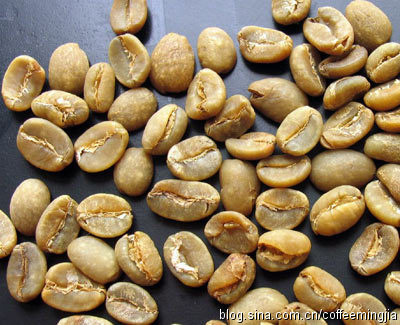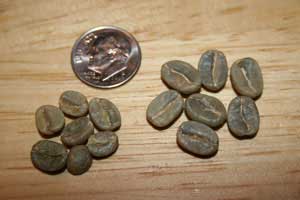Main points of knowledge about coffee raw beans: introduction to the trade of coffee raw beans and text analysis of sack packaging
Previous blog post: the hometown of coffee once introduced that the main production places of coffee in the world are concentrated in the narrow strip with the equator as the center line and latitudes within 25 degrees from north to south, like a belt around the earth, commonly known as the coffee belt (Coffee Belt). Among the more than 60 producing countries in the coffee belt, with the exception of high local consumption in Brazil, exports account for a high proportion of total output, such as 99% in Uganda, 88% in Luanda, 79% in Ecuador and 66% in Colombia. For some countries, it is an extremely important source of foreign exchange, so in some war-torn countries, such as El Salvador and Rwanda, the only cause that is unaffected and functioning normally is the production and trading of coffee beans.
Coffee Producing CountryCoffee Harvesting Time60 Kg Bags harvested in199960 Kg bags exported in1999
BrazilMarch-October27,170,00023135000
ColombiaOctober-February and April-June9,300,0009995000
Costa RicaAtlantic coast: August-November. Pacific coast: September-December2,467,0002196000
Dominican RepublicAugust-June1,058,000161000
EcuadorJune-October1,533,000988000
EthiopiaAugust-January3,833,0001818000
GuatemalaOctober-January4,500,0004669000
HaitiOctober-November and February-March385,000161000
HondurasOctober-March3,067,0001987000
Indonesia May-December7,833,0005084000
JamaicaAugust-September40,00024000
KenyaOctober-December (main) and June-August1,433,0001113000
MalawiDecember-February61,00054000
MexicoHigh Altitudes: November-January. Low altitudes: August-November6,193,0004358000
NicaraguaSouth: November-January and August-September. North: December-March1,304,000983000
Papua New GuineaApril-September1,286,000132000
TanzaniaOctober-December773,000634000
UgandaSeptember-December4,000,0003841000
VenezuelaSeptember-March1,073,000452000
ZambiaOctober-March45,00054000
ZimbabweJuly-October189,000141000
The production and supply of global coffee beans are seasonal. For example, the production season is from March to October in Brazil, October to March in Colombia, Kenya, Mexico, Guatemala and Honduras, August to September in Jamaica, June to October in Ecuador and May to December in Indonesia. Jamaica has the shortest production period, which also shows the value of Blue Mountain coffee beans.
About 70% of the world's total production flows to the trading market, with North America and Western Europe as the main markets, accounting for about 80% of the total trading volume. The United States market covers a wide range of quality, but it is generally dominated by mild flavors, with a wide range of sources of supply; the United Kingdom and Germany are dominated by conventional sources of supply, such as East Africa; France has close ties with C ô te d'Ivoire and French West Africa; the Netherlands is combined with Indonesia. Nordic countries have the highest individual consumption, with mild Arabica coffee beans being the most popular, as are Germany, while France and Italy prefer Robusta coffee beans, while Latin countries prefer rich black coffee.
The most important coffee bean trading organization in the world is the ICO http://www.ico.org/index.asp) (International Coffee Organization), which has 50 exporting countries and controls 99 per cent of global production. The exporting countries under ICO are divided into two categories. The main producing countries (24 countries) have to follow the basic quotas, while those with low production do not have to be restricted by the quotas. Coffee beans are currently traded in more than 70 million bags (60 kg each) throughout the year, of which major quota countries account for more than 90 per cent.
The trading of raw coffee beans is mainly divided into the Natural Exchange Market (Physical Trade) and the futures markets in London and New York. Raw coffee beans are packed in gunny bags. The standard packing weight is 60 kg. The origin, grade and ICO certificate number should be marked on the bag for quota tracking and checking.
In the picture, the bottom line of the raw coffee bean sack is the ICO certificate number.
Source:
The blog of the coffee wizard
Important Notice :
前街咖啡 FrontStreet Coffee has moved to new addredd:
FrontStreet Coffee Address: 315,Donghua East Road,GuangZhou
Tel:020 38364473
- Prev

Introduction to the main points of the knowledge of raw coffee beans: a detailed explanation of the classification of raw coffee beans
The last step in the processing of raw coffee beans is grading, so what are the grading methods of raw coffee beans? Do different countries adopt the same approach? At present, there are three main rating criteria for raw coffee beans, and different countries adopt different rating methods according to their own production conditions and national conditions (not all coffee producing countries adopt the same method).
- Next

Knowledge points of Coffee Raw Bean: the concept of Fine Coffee Specialty Coffee (1)
The traditional classification of coffee beans is usually based on the classification criteria defined by the coffee producing countries, and then agreed to become common in the international market and traded under such a tacit understanding. For a long time, coffee producing countries have their own classification and evaluation criteria for coffee, which serve as the pricing guidelines in the coffee market. But slowly in recent years, coffee consuming countries have begun to demand unified evaluation criteria.
Related
- Guji coffee producing area of Guji, Ethiopia: Humbela, Shakiso, Wulaga
- What is the most expensive variety of Qiloso in BOP multi-variety group?
- How to store the coffee beans bought home?
- Why are Yemeni coffee beans so rare now?
- Ethiopian Sidamo all Red Fruit Sun Sun Santa Vini Coffee beans
- SOE is mostly sour? What does it mean? Is it a single bean? what's the difference between it and Italian blending?
- Is Italian coffee beans suitable for making hand-brewed coffee?
- How to choose coffee beans when making cold coffee? What kind of coffee beans are suitable for making cold coffee?
- Just entered the pit to make coffee, what kind of coffee beans should be chosen?
- Can only Japan buy real Blue Mountain Coffee? What are authentic Jamaican Blue Mountain coffee beans?

